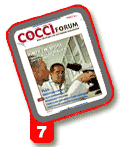
Other articles
in this issue
COCCI Views
Putting Ideas to the Test
 Charles Broussad,
Schering-Plough Animal Health
|
These days, as we head into
another US presidential election
year, it seems everyone
— politicians, talk-show
hosts, newspaper columnists
and even the kid at the video
store — has an opinion or
theory about how to fix the problems of the world. It’s
good to see people thinking and sharing their views. But
as we all know from experience, it’s one thing to present
an idea. Making it work is entirely another.>
Now I’m smart enough to realize that managing coccidiosis
in poultry is a long way from balancing the budget,
creating more jobs or bringing us lasting peace and
security. Nevertheless, a recent experience I had evaluating
long-term options for coccidiosis control underscored
the value of presenting new ideas, putting them to the
test and making them work in the real world.
Two years ago, Schering-Plough Animal Health
launched Clinacox (diclazuril), a new-generation synthetic
anticoccidial that was shown to be highly effective
against the many wild and resistant strains of Eimeria in
the field. Birds medicated with Clinacox also showed significant
improvements in feed conversion — often a 5-
point1 boost — while also yielding significant gains in
energy efficiency.
Knowing that all in-feed anticoccidials can lose some
punch with continuous usage, we strongly urged the
poultry industry to use Clinacox judiciously — either for
one cycle annually or in a shuttle program (starter or
grower ration, but not both) in two sequential cycles.
Because Clinacox cleaned up the resistant Eimeria
populations, we then recommended rotating to the liveoocyst
vaccine, Coccivac-B, and using it two to three
cycles. The theory was that Coccivac could start from a
clean slate while also seeding houses with older, highly
susceptible strains of Eimeria. This practice had already
been proven with ionophores, but the jury was still out
when it came to using Coccivac in a program with
Clinacox. As Dr. Rick Phillips puts it in the trial report on
page 4: “Despite the research and all the field reports in
hand, we felt it was important to test our hypothesis in
the field where the proverbial ‘rubber meets the road’.”
So that’s just what we did. We took a theory or a good
idea, put it to the test in real-world conditions and
showed how these two important tools — Clinacox and
Coccivac — could be used to develop a long-term, integrated
approach to coccidiosis management. It’s gratifying
to read that one of the independent cooperators in
the study, Greg Mathis, PhD, of Southern Poultry
Research in Athens, Georgia, called the landmark trial
“one of the most coccidiosis-significant studies” he’s
worked on in more than 20 years.
This latest field trial is, of course, another good example
of the commitment that Schering-Plough Animal
Health has made to the worldwide poultry industry. We’ll
continue to bring this expertise and sound science to the
field through articles in CocciForum, as well as through
presentations at industry meetings and our new series of
Technical Service Bulletins. We can’t do it alone, however.
As I said before, it seems everyone has an opinion
about how to fix the problems of the world, including
coccidiosis in poultry. We hope that you’ll continue sharing
yours with us.





 © 2000 - 2021. Global Ag MediaNinguna parte de este sitio puede ser reproducida sin previa autorización.
© 2000 - 2021. Global Ag MediaNinguna parte de este sitio puede ser reproducida sin previa autorización.